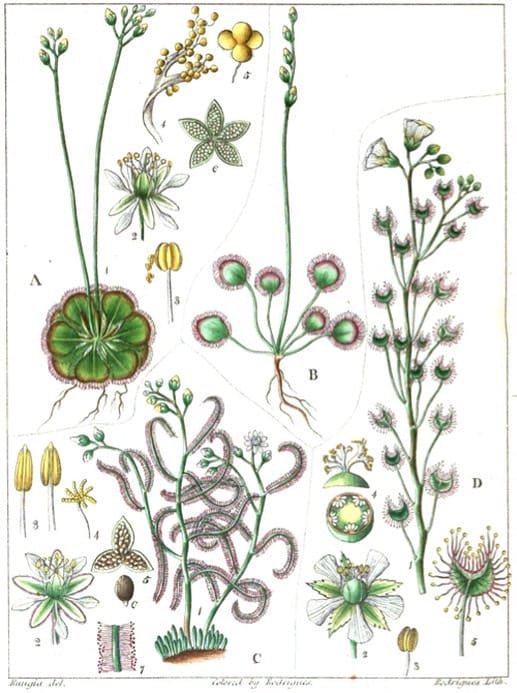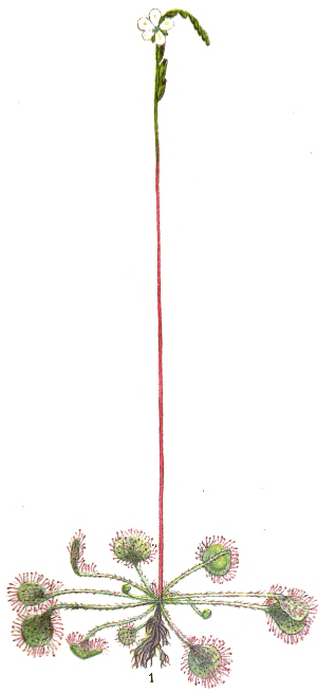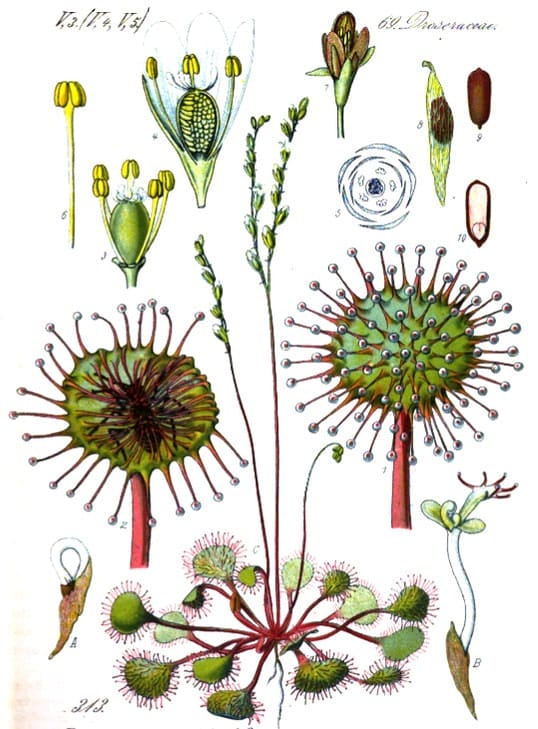Drosera, Sundew
Ros Solis, Lustwort, Herba RorellaeBdud rtsi rtag ngu བདུད་རྩི་རྟག་ངུ་ (Tibet)

|

|
|
A. D. burmanni; B. D. intermedia; C. D. indica; D. D. peltata Illustrations of Indian Botany, Wight, 1840 |
D. rotundifolia Medicinal Plants, Millspaugh, 1892 |
 D. rotundifolia
D. rotundifoliaFlora von Deutschland, Kohler, 1886
Botanical name:
Drosera spp.
1. D. rotundifolia (Common, European or Round-leaved Sundew)
2. D. peltata (Pale Sundew)
3. D. intermedia (Medium Sundew)
Round and Long-leaved varieties were known.
Parts used:
Whole plant
Temperature & Taste:
Neutral/slightly Warm, dry. Bitter, Pungent, Sour. Slightly Toxic.
Classifications
3K. EXPECTORANT
TCM:
P. Clear Phlegm
Uses:
1. Warms and Strengthens the Kidneys:
-impotence, lack of sex drive associated with cold and weak Kidneys
-juice and herb have traditionally been used as an Aphrodisiac as well as being used as a tonic in old age and to promote longevity
-restores vigor, balances the Three Humors; used in Rejuvenating compounds (Tibet)
-rheumatic pain of the back and legs (lower body) associated with Cold, Damp, and Weak Kidneys. (TCM)
-promotes menstruation when obstructed by cold.
2. Stops Cough, Clears Phlegm:
-chronic coughs and wheezing; chronic Bronchitis or Asthma
-spasmodic coughs; persistent coughs with dry airways; uncontrollable tickling coughs; paroxysms of coughing with thick mucus
-Whooping Cough; Cough of Measles.
-traditionally used for consumption and phthisic, for which it may only be suitable in the early stages:
-‘accounted good to help those that have a Salt Rheum distilling on the Lungs which causes consumption … held to be good for phthisis, wheezings, shortness of breath and Cough; also to heal ulcers in the Lungs’ (Culpeper)
–Grieves also lists it for ‘incipient phthisis and chronic Bronchitis’
3. Settles Wind, Comforts the Heart:
-Epilepsy; Hypertension
-Arteriosclerosis in modern times
-Temporal Headache (TCM)
-poor functioning of the sense organs (Tibet)
4. Resists Poison:
-Plague, Fevers and Influenza. (Salmon)
5. Warms the Stomach:
-weakness or irritability of the stomach, nausea and upset stomach.
-stomach Ulcers and Gastritis.
6. Externally:
i. the fresh leaves were bruised with salt and applied to raise blisters.
ii. the distilled water is good externally for old Ulcers and Fistulas, and held in the mouth, it cures toothache (from cold).
iii. ‘The juice destroys Warts and Corns, if a little be frequently put upon them’. (Culpeper)
Dose:
Infusion: 1–3 grams;
Tincture (1:5 in 60% alcohol): ½–1 ml;
–Two fluid drams of the saturated tincture can be added to 4 fluid drams of water or wine, and this can be taken in teaspoonful doses.
–For Children (4–8 years old) 2 drops may be given in a little water several times daily for Whooping Cough; some recommended diluting 1 part tincture to 9 parts water, this being given in 3–5 drops doses for Whooping Cough;
–4–10 drops is given in a little water 2 or 3 times daily for several weeks in the beginning of consumption.
Fluid Extract (1:1 in 25% alcohol): ½–2 mls (or 5–20 drops);
Solid Extract: 2–5 grains
Distilled Water: 2–3 oz.
In TCM, the whole fresh plant is made into a paste with water, and these are rolled into small pills. These may then be placed over sore parts and stuck on with plaster. Alternatively, 1–4 of these small pills may be taken internally (Barefoot Doctors Manual).
Comment
1. Weiss and others have suggested Thyme and Sundew are synergistic.
2. Its use may darken the urine.
3. Start with small doses and build up gradually.
4. The juice (‘dew’) that forms on the plant is collected from the plant and made into a tincture with Aqua Vitae. It strengthens the Head, Stomach and Liver, cures Hot Headaches, prevents and cures Plague, and is given for heat, pain and inflammation of the Eyes.
Main Combinations:
1. Whooping Cough, Bronchitis:
i. Weiss suggests Thyme and Sundew to be synergistic in effect when used for the Lungs; especially for Whooping Cough
ii. Sundew, Thyme, Cowslip (Meyer)
iii. Sundew with Violet and Peony root (Kroeber)
iv. Sundew with Elder flower, Lance-leaf Plantain and Heartsease (Kneipp)
v. Sundew with Thyme, Licorice, Lance-leaf Plantain, Eucalyptus (Peyer)
vi. Sundew with Peppermint, Cowslip, Soapwort, Violet root, Thyme, Mullein
2. Asthma, Sundew has been combined with Pill-Bearing Spurge
3. Asthmatic Bronchitis, Sundew with Polygala amara, Horehound, Tansy, Germander, Fennel seed (Kroeber)
4. To Warm the Kidneys, Sundew with Cinnamon, Cloves, Mace, Ginger, Nutmeg (as in Rosa Solis)
5. Consumption, to preserve from Epidemics, and for Palpitations, Sundew with Licorice, Nutmeg, Cinnamon, Sandalwood, Aniseed, Coriander, Rose, Ginger, Clove
Cautions:
1. Avoid overdose or long-term use
2. Not suitable for Yin deficiency or Yin deficient Heat conditions.
From Gerard:
‘The later Physicians have thought this herb to be a rare and singular remedy for all those that be in a Consumption of the Lungs, and especially the distilled water thereof: for as the herb doth keep and hold fast the moisture and dew, and so fast, that the extreme drying heat of the Sun cannot consume and waste away the same: so likewise men thought that herewith the natural and radical humidity in mens bodies is preserved and cherished. But the use thereof doth otherwise teach, and reason showeth the contrarie: for seeing it is an extreme biting herb, and that the distilled water is not altogether without this biting quality, it cannot be taken with safety: for it hath also been observed, that they have sooner perished that used the distilled water hereof, than those that abstained from it, and have followed the right and ordinate course of diet’.
Main Preparations used:
Tincture, Distilled Water (Simple and Compound)
